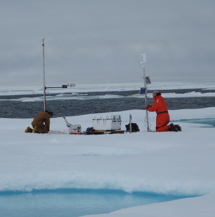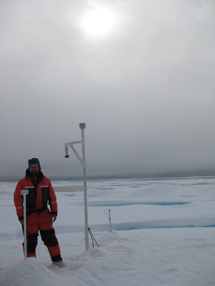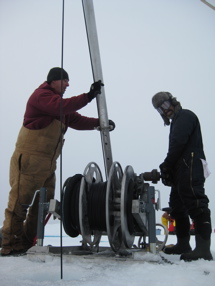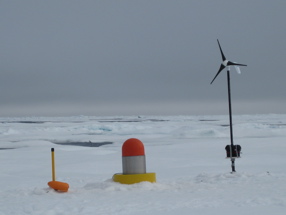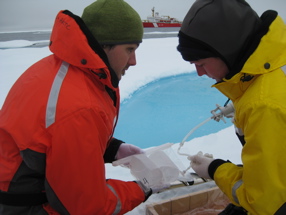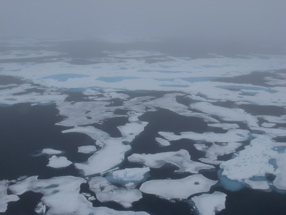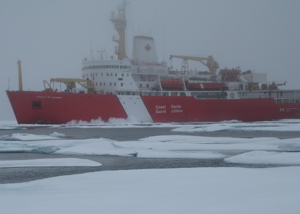Gerty WardAugust 8, 2008Today was Mega Buoy day, meaning that 4 buoys were deployed on one ice floe, creating an Ice-Based Observatory (IBO). The data collected by these 4 systems will give scientists a detailed picture over time of Arctic ice, water and weather dynamics. (And no one has to stay here over winter!) David Meldrum of the Scottish Association for Marine Science (SAMS) deployed his SAMS- Ice Mass Balance Station (IMBS). David is trying to measure the flux of heat through the ice from both the sun and the water. His station has 3 systems to collect data. The first system measures the temperature of the ice, and the air just above and water just below. The second collects both incoming and outgoing solar radiation. Using two sets of sensors, one pointing up and the other pointing down, he measures how much of the incoming radiation is reflecting back off the ice into the atmosphere. Question: what is the name of the ratio of reflected to incoming solar radiation? The third system collects general weather data: air temperature, wind speed, precipitation, air pressure and humidity. It is all powered by 2 batteries charged by the wind and the sun! The data collected here will allow David to add to his model of ice dynamics. More information on his buoy system can be found here: www.sams.ac.uk Mike Dempsey deployed an Ice Mass Balance Buoy (IMB buoy) for the US Army Cold Regions Research Engineering Lab in Dartmouth, NH.
This system measures the accumulation of ice and snow from both above and below the ice floe. It has a string of thermistors that record the temperatures of the boundary layer*, the area where ice becomes water and water becomes ice. Understanding how quickly the ice melts in summer and freezes in winter offers another measure of the Arctic climate and how it is changing. WHOI deployed two buoys here. Another ITP was installed (see 3 August Journal entry and https://www.whoi.edu/itp/ for details on this ice based system). They also put out an Autonomous Ocean Flux Buoy (AOFB) for the Naval Post-Graduate School. This system measures turbulence between the ice-ocean boundary layer. These data offer a direct measurement of temperature, salinity and momentum* fluxes between the ice and water. Details on this buoy are here: www.oc.nps.navy.mil\~stanton\fluxbuoy
Ice and snow samples were also collected here, giving a more complete picture of this IBO. Putting all these data together, scientists can build a model that incorporates past data, past cause-and-effect connections, and applies them to the future.
TERMS Last updated: October 7, 2019 | |||||||||||||||||||||||||||||||||
Copyright ©2007 Woods Hole Oceanographic Institution, All Rights Reserved, Privacy Policy. | |||||||||||||||||||||||||||||||||


